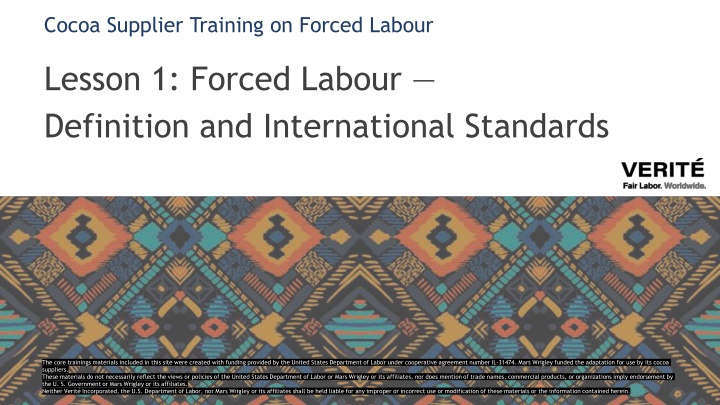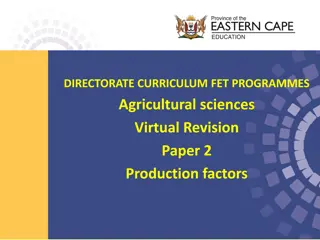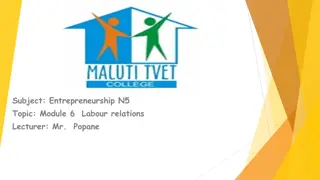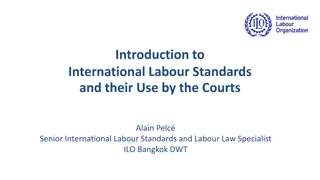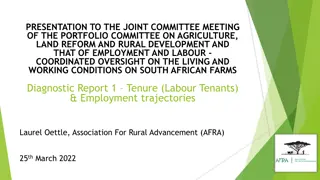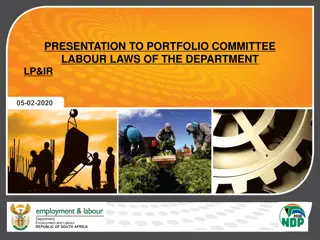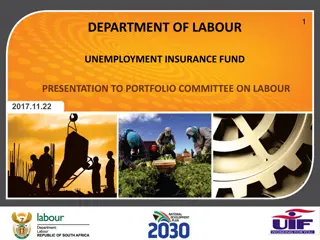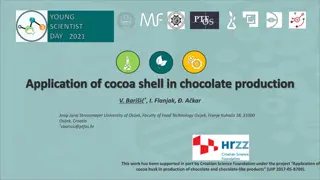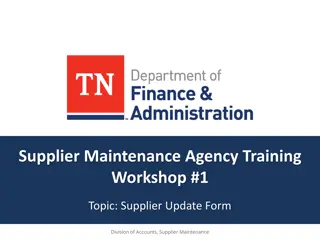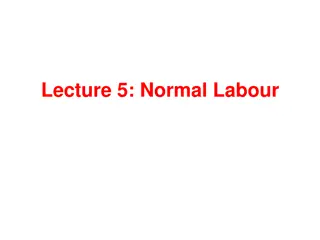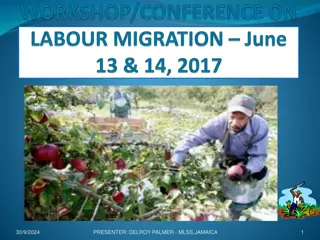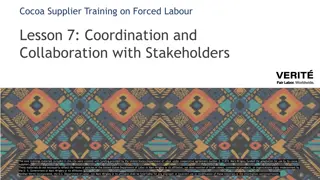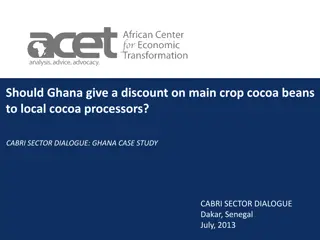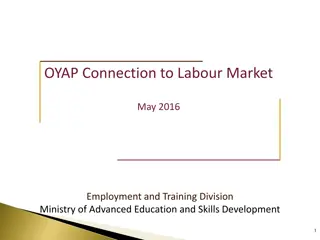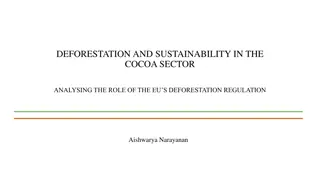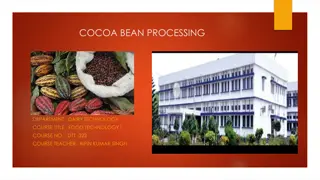Cocoa Supplier Training on Forced Labour: International Standards & Definitions
This training module covers the definition and international standards related to forced labour in the cocoa industry. It discusses modern slavery practices, the ILO's definition of forced labour, and relevant international instruments such as the ILO Forced Labour Convention. The content emphasizes the importance of preventing, prosecuting, and providing remedies for forced labour situations.
Download Presentation

Please find below an Image/Link to download the presentation.
The content on the website is provided AS IS for your information and personal use only. It may not be sold, licensed, or shared on other websites without obtaining consent from the author.If you encounter any issues during the download, it is possible that the publisher has removed the file from their server.
You are allowed to download the files provided on this website for personal or commercial use, subject to the condition that they are used lawfully. All files are the property of their respective owners.
The content on the website is provided AS IS for your information and personal use only. It may not be sold, licensed, or shared on other websites without obtaining consent from the author.
E N D
Presentation Transcript
Cocoa Supplier Training on Forced Labour Lesson 1: Forced Labour Definition and International Standards The core trainings materials included in this site were created with funding provided by the United States Department of Labor under cooperative agreement number IL 31474. Mars Wrigley funded the adaptation for use by its cocoa suppliers. These materials do not necessarily reflect the views or policies of the United States Department of Labor or Mars Wrigley or its affiliates, nor does mention of trade names, commercial products, or organizations imply endorsement by the U. S. Government or Mars Wrigley or its affiliates. Neither Verit Incorporated, the U.S. Department of Labor, nor Mars Wrigley or its affiliates shall be held liable for any improper or incorrect use or modification of these materials or the information contained herein.
Objective To provide an overview of international labour standards and definitions of key terms related to forced labour 2 2 Cocoa Supplier Training on Forced Labour
Understanding the problem What is forced labour? How is it defined? Modern slavery refers to a range of exploitative practices, including: forced labour human trafficking debt bondage What are the relevant international standards? 3 3 Cocoa Supplier Training on Forced Labour
What is forced labour? All work or service which is exacted from any person under the menace of any penalty and for which the said person has not offered himself voluntarily. ILO Forced Labour Convention (1930, No. 29) the most authoritative convention on forced labour Note: The ILO definition excludes compulsory military service; normal civic obligations of a nation or community; work mandated as a result of a court conviction; and work required in certain emergency situations.
International Instruments International Instrument Highlights Ratified by Ghana? ILO Forced Labour Convention 29 (1930) The most authoritative convention on Forced Labor Yes 1957 Protocol 29 (2014) Legally binding instrument regarding forced labour; requires states to: Criminalize forced labour Prosecute cases Prevent the problem Provide victims access to remedy Under discussion (as of writing) ILO Convention 105 on the Abolition of Forced Labour (1957) Concerns forced labour imposed by the state ILO Forced Labour Recommendation 203 (2014) Describes measures to support the elimination of forced labour: Prevention Protection Remediation 5 5 Cocoa Supplier Training on Forced Labour
Key Components: Threat or menace of any penalty: a wide range of penalties can be used to compel someone to work Involuntary work: any work taking place without the free and informed consent of the worker Can include: Can include: Work taking place under deception Coercion or threats of coercion Work in which the worker is uninformed about conditions Witnessing coercion imposed on others
Questions to consider Has the worker entered into a job of their own free will and based their decision on accurate information provided without deception? If not, the work may be involuntary. Can the worker leave the job freely without threat or punishment to themselves or their family? If not, there may be threat or menace of penalty at play that prevents the workers from leaving. 7 7 Cocoa Supplier Training on Forced Labour
Identifying forced labour It can sometimes be challenging to identify involuntary work and threat or menace of penalty, and therefore to identify forced labour. To address this challenge, the ILO and the International Conference of Labour Statisticians (ICLS) developed specific indicators of forced labour related to a worker s experience. ILO s 2012 Hard to see, harder to count Survey guidelines to estimate forced labour of adults and children Updated by the ICLS s 2018 Guidelines concerning the measurement of forced labour The forced labour indicators help to identify the presence of involuntary work and/or a threat or menace of penalty.
ICLS 2018 Indicators Involuntary Work Threat or Menace of Any Penalty Unfree recruitment at birth or through transaction such as bonded labour Threats or violence against workers or workers families and relatives, or close associates Situations in which the worker must perform a job of different nature from that specified during recruitment without a person s consent Restrictions on workers movement Debt bondage or manipulation of debt Withholding of wages or other promised benefits Abusive requirements for overtime or on call work that were not previously agreed with the employer Withholding of valuable documents (such as identity documents or residence permits) Abuse of workers vulnerability through the denial of rights or privileges, threats of dismissal, or deportation Work in hazardous conditions to which the worker has not consented, with or without compensation or protective equipment Work with very low or no wages Degrading living conditions imposed by the employer, recruiter, or other third party Work for other employers than agreed Work for a longer period of time than agreed Work with no or limited freedom to terminate work contract 9 9 Cocoa Supplier Training on Forced Labour
Types of coercion Top forms of coercion Men were more likely to face: Threats against family Withheld wages Confinement Denial of food and sleep Threats of legal action Wage withholding 24% Threats of violence 17% Acts of physical violence 16% 12% Threats against family Women were more likely to face: 31% Other forms of coercion Sexual violence Passport withholding Forced labour cases 10 10 Cocoa Supplier Training on Forced Labour
Questions for consideration Do you think forced labour is currently a problem in supply chains? Who do you think could be exposed to forced labour on a farm? 11 11 Cocoa Supplier Training on Forced Labour
References Ending Forced Labour by 2030: A Review of Policies and Programmes, International Labour Organization (ILO), 2018. p. 38. https://www.ilo.org/wcmsp5/groups/public/--- ed_norm/---ipec/documents/publication/wcms_653986.pdf. 12 12 Cocoa Supplier Training on Forced Labour
